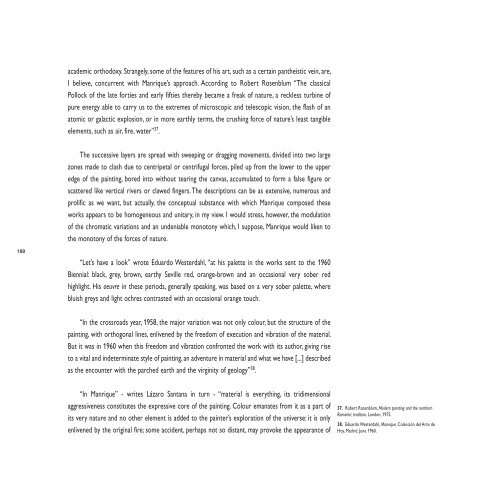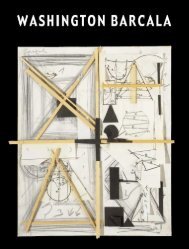VERSIÓN INGLESA ENGLISH VERSION - Fundación César Manrique
VERSIÓN INGLESA ENGLISH VERSION - Fundación César Manrique
VERSIÓN INGLESA ENGLISH VERSION - Fundación César Manrique
Create successful ePaper yourself
Turn your PDF publications into a flip-book with our unique Google optimized e-Paper software.
188<br />
academic orthodoxy. Strangely, some of the features of his art, such as a certain pantheistic vein, are,<br />
I believe, concurrent with <strong>Manrique</strong>’s approach. According to Robert Rosenblum “The classical<br />
Pollock of the late forties and early fifties thereby became a freak of nature, a reckless turbine of<br />
pure energy able to carry us to the extremes of microscopic and telescopic vision, the flash of an<br />
atomic or galactic explosion, or in more earthly terms, the crushing force of nature’s least tangible<br />
elements, such as air, fire, water” 37 .<br />
The successive layers are spread with sweeping or dragging movements, divided into two large<br />
zones made to clash due to centripetal or centrifugal forces, piled up from the lower to the upper<br />
edge of the painting, bored into without tearing the canvas, accumulated to form a false figure or<br />
scattered like vertical rivers or clawed fingers. The descriptions can be as extensive, numerous and<br />
prolific as we want, but actually, the conceptual substance with which <strong>Manrique</strong> composed these<br />
works appears to be homogeneous and unitary, in my view. I would stress, however, the modulation<br />
of the chromatic variations and an undeniable monotony which, I suppose, <strong>Manrique</strong> would liken to<br />
the monotony of the forces of nature.<br />
“Let’s have a look” wrote Eduardo Westerdahl, “at his palette in the works sent to the 1960<br />
Biennial: black, grey, brown, earthy Seville red, orange-brown and an occasional very sober red<br />
highlight. His oeuvre in these periods, generally speaking, was based on a very sober palette, where<br />
bluish greys and light ochres contrasted with an occasional orange touch.<br />
“In the crossroads year, 1958, the major variation was not only colour, but the structure of the<br />
painting, with orthogonal lines, enlivened by the freedom of execution and vibration of the material.<br />
But it was in 1960 when this freedom and vibration confronted the work with its author, giving rise<br />
to a vital and indeterminate style of painting, an adventure in material and what we have [...] described<br />
as the encounter with the parched earth and the virginity of geology” 38 .<br />
“In <strong>Manrique</strong>” - writes Lázaro Santana in turn - “material is everything, its tridimensional<br />
aggressiveness constitutes the expressive core of the painting. Colour emanates from it as a part of<br />
its very nature and no other element is added to the painter’s exploration of the universe: it is only<br />
enlivened by the original fire; some accident, perhaps not so distant, may provoke the appearance of<br />
37. Robert Rosenblum, Modern painting and the northern<br />
Romantic tradition, London, 1975.<br />
38. Eduardo Westerdahl, <strong>Manrique</strong>, Colección del Arte de<br />
Hoy, Madrid, June 1960.
















![Becas y premios de la Fundación César Manrique [1997-2006]](https://img.yumpu.com/20766851/1/184x260/becas-y-premios-de-la-fundacion-cesar-manrique-1997-2006.jpg?quality=85)
